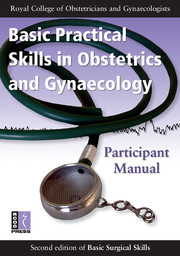Module 2 - Obstetric skills
Published online by Cambridge University Press: 05 July 2014
Summary
Introduction
Many anatomical structures, such as the uterus and major blood vessels, are enlarged in pregnancy and the tissues are often soft, oedematous and easily bruised. This is particularly evident after a woman has given birth and can hinder the ready recognition of structures and tissue planes. As a consequence, surgery in pregnancy and in the postpartum period can be complicated by the rapid loss of a large volume of blood.
The trainee obstetric surgeon will become accustomed to operating in conditions of haemorrhage that would rarely be encountered in other surgical disciplines but this does not excuse poor operative technique. On the contrary, in order to function well in these difficult circumstances, the obstetrician must adopt a particularly careful and skilled approach to surgery. For example, it is important that you differentiate between bleeding inevitably associated with the conditions being managed and bleeding consequent upon poor technique. Tissues should be handled gently, meticulous haemostasis should be obtained at the earliest opportunity and divided structures should be reapproximated accurately and without tension.
In this module, you will learn about the anatomy of the pelvic floor and follow the normal vaginal birth of a singleton cephalic baby at full term. These topics should be revised before your attendance at the Basic Practical Skills course.
Three scenarios will be encountered on the obstetric day, as detailed at the beginning of the module. If you read the notes attached to each scenario before your training day you will gain most benefit from the experience.
- Type
- Chapter
- Information
- Basic Practical Skills in Obstetrics and GynaecologyParticipant Manual, pp. 33 - 69Publisher: Cambridge University PressPrint publication year: 2010



